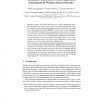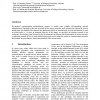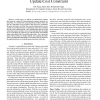DCOSS
2005
Springer
14 years 5 months ago
2005
Springer
Implanted biological sensors are a special class of wireless sensor networks that are used in-vivo for various medical applications. One of the major challenges of continuous in-vi...
DCOSS
2005
Springer
14 years 5 months ago
2005
Springer
Abstract. Achieving optimal battery usage and prolonged network lifetime are two of the most fundamental issues in wireless sensor networks. By exploiting node and data redundancy ...
DCOSS
2005
Springer
14 years 5 months ago
2005
Springer
Abstract. Wireless sensor networks can be very useful in applications that require the detection of crucial events, in physical environments subjected to critical conditions, and t...
ARCS
2005
Springer
14 years 5 months ago
2005
Springer
Bio-inspired communication methodologies promise to enable more scalable self-organizing network infrastructures. Especially in the area of mobile ad hoc sensor networks, such sol...
ADHOCNOW
2005
Springer
14 years 5 months ago
2005
Springer
— In this paper, we address an optimization problem that arises in context of cache placement in sensor networks. In particular, we consider the cache placement problem where the...
ADHOCNOW
2005
Springer
14 years 5 months ago
2005
Springer
Sensor nets have many undisputed fields of application. A paradigm of communication is the use of one control channel in the MAC layer. We challenge this paradigm for nodes with v...
WS
2005
ACM
14 years 5 months ago
2005
ACM
Many key pre-distribution techniques have been developed recently to establish pairwise keys for wireless sensor networks. To further improve these schemes, researchers have propo...
WS
2005
ACM
14 years 5 months ago
2005
ACM
In this paper, we analyze attacks on existing time synchronization protocols for wireless sensor networks. We propose a secure time synchronization toolbox to counter these attack...
WOWMOM
2005
ACM
14 years 5 months ago
2005
ACM
Recent work on key establishment for sensor networks has shown that it is feasible to employ limited Elliptic Curve Cryptography in sensor networks through hybrid protocols. In th...
SENSYS
2005
ACM
14 years 5 months ago
2005
ACM



